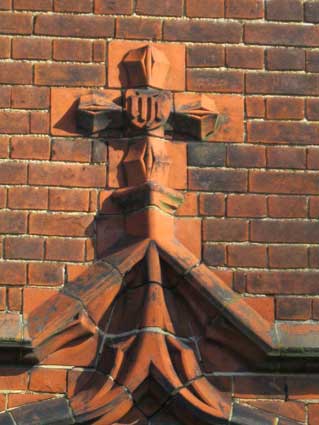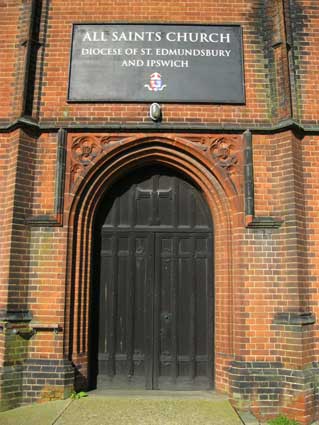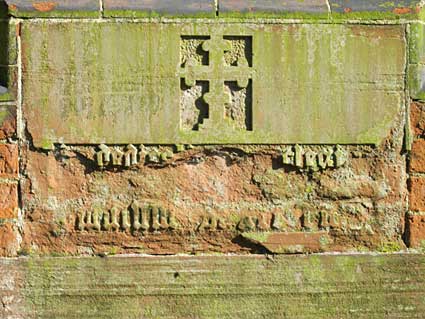All
Saints Church
Standing on the corner of Chevallier Street and Waterloo
Road
is this striking red brick church. with its lofty octagonal tower.

 2014 images
2014 images
Chevallier Street celebrates Harriet Temple Chevallier who
married John Wilkinson Cobbold (of the famous local brewing family) in
Aspall, Suffolk in 1796. Their son, John Chevallier
Cobbold, was born in 1797 and took his mother's surname as a middle name.
John Chevallier Cobbold had a significant influence on railway
development in East Anglia (see EUR). [Information from the Cobbold Family
History Trust, see Links]
Simon Knott writes: "Suffolk doesn't have many 19th century churches -
or, at least, not many that aren't rebuilds of medieval ones. The best
of the new are probably the Anglican Ipswich St Bartholomew and Bury St
John, and the Catholic Ipswich St Pancras and Lowestoft Star of the
Sea. These are all excellent churches, worthy buildings for parish and
county alike. All Saints, then, is something quite unusual for Suffolk.
It is a run of the mill Victorian redbrick church. That it is a run of
the mill Lancashire-style redbrick church is probably because the
architect was Samuel Wright of Blackpool, who won the 1887 competition,
possibly to his own surprise. He won £50 for the effort. The parish was
carved out of St Matthew." [Simon's
Suffolk Churches, see Links]


On the Waterloo Road elevation is a rear doorway with, as the
detail shows some complex moulding at the apex with gothic lettering
motif at the centre of the crucifix: 'IHC'. The so-called 'sacred
monogram', the letters 'IHC' are the first three letters of the Greek
word for Jesus IHCOYC. See St Peter's
Church for another version of this.


The sacred monogram appears on the spandrels of the main door,
as shown by the close-up (lower centre).

This dedication stone just round the corner from the main door
and low down – note the algae – has not survived the weather as well as
the rest of the church's fabric.
Muriel Clegg in The way we
went (see Reading list) tells us that
one interesting feature of the foundation stone laying of the Corn
Exchange in 1880 was the prominent part played by Freemasons. 'Six
years later an even more impressive masonic ceremonialwas
observed when the foundation stone of All Saints Church (then Blenheim
Road, now Chevallier Street) was laid by the mayor, B.P. Grimsey. The
procession to the church, in addition to the civic dignitaries and the
band, included Brethren of the Lodges, cornucopia with corn borne by
the Master of the Lodge, two ewers of wine and oil carried by Masters
of the Lodges, the trowel and mallet, the phial containing coins, etc.
and other insignia of office borne by various Provincial Grand
Officers. All the Freemasons wore aprons and collars, medals and
orders. It was said that "never since the days of Wolsey has Ipswich
ever seen such an imposing festival".'
Home
Please email any comments
and contributions by clicking here.
Search Ipswich
Historic Lettering
©2004 Copyright
throughout the Ipswich
Historic Lettering site: Borin Van Loon
No reproduction of text or images without express
written permission

 2014 images
2014 images



